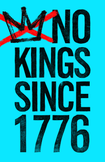
Core Insights
- A capital at a crossroads: Washington, D.C. prepares for a massive military parade marking President Donald Trump’s 79th birthday on June 14, 2025—while grassroots protest group ‘No Kings’ calls for a nationwide “day of action.”
- The rise of rage: ‘No Kings’ markets itself as nonviolent, but its recruitment language targets the “outraged”—raising red flags amid an epidemic of American-on-American violence.
- Whose day is it anyway? Security agencies and the public brace for the potential convergence of patriotic celebration and civil unrest on the same city stage.
D.C. Braces for a Volatile Showdown on Trump’s Birthday
By Samuel Lopez – USA Herald
Washington, D.C. — As President Donald J. Trump prepares to mark his 79th birthday with a military parade scheduled for June 14, 2025 at 6:00 PM, a parallel drama is brewing just beneath the surface. The city isn’t just preparing for flags, fanfare, and a display of American might. It is bracing for the arrival of “No Kings,” a protest group whose influence and intentions have become a matter of urgent national conversation.
For months, the White House has planned a grand military procession—tanks on Constitution Avenue, marching bands, the President waving to supporters. This display, designed to celebrate both national pride and Trump’s personal milestone, would in any year be a headline event. But 2025 is not just any year.
Enter “No Kings.” This amorphous group, with offshoots like “No Kings Here,” claims June 14 as a “national day of action,” urging Americans to protest what it calls “the increasing authoritarian excesses and corruption of the Trump administration.”
While its website loudly proclaims a commitment to nonviolence, the rhetoric beneath the surface is anything but reassuring. The group’s own call to action appeals to those who are “outraged”—by attacks on civil rights, economic hardship, disappearances, and assaults on free speech.
“Whether you’re outraged by attacks on civil rights, skyrocketing costs, abductions and disappearances, the gutting of essential services, or the assault on free speech—this moment is for you.”
— No Kings official statement
On paper, “No Kings” waves the flag of peaceful protest. But the group’s digital trail suggests something far more complex—and potentially riskier. Their recruitment strategies explicitly target Americans who are “outraged,” a word that, by definition, means “an extremely strong reaction of anger, shock, or indignation.” In today’s social climate, “outrage” is an energy as combustible as gasoline.
USA Herald, has reported extensively on what can only be described as an epidemic of American-on-American violence. Data from the CDC and FBI show rising rates of assault, battery, and unprovoked attacks, often fueled by political or social grievances. In such a context, groups that amplify the grievances of the already agitated run the risk—intentionally or not—of unleashing forces they cannot control.
The true size and shape of “No Kings” remain a mystery. Its affiliates operate under various similar-sounding names, some registered as LLCs in the California Secretary of State database. Digging deeper, some founders linked to these LLCs espouse radical views on social media, calling for sweeping systemic change and expressing little patience for compromise.
Security officials have noted that the “leaderless resistance” model—popularized by both left- and right-wing movements—makes these organizations particularly unpredictable. Without clear leadership or centralized planning, actions can spiral out of control, especially when crowds are incited by outrage rather than organization.
From a legal and insurance perspective, the scheduled convergence of a presidential parade and a mass protest on the same day in the nation’s capital is a textbook risk scenario. D.C. authorities and the Secret Service are preparing for every contingency, but the insurance implications are massive. Any outbreak of violence, vandalism, or injury could trigger costly claims—leaving public agencies, private businesses, and protest organizers locked in legal crossfire.
What happens if protest organizers are found liable for damages caused by individuals they mobilized? Recent lawsuits against groups accused of inciting violence suggest that courts are increasingly willing to test the limits of First Amendment protections in the era of mass mobilization.
It’s worth noting that “No Kings” adamantly denies any intent to incite violence. But as any seasoned observer of protest politics knows, words and deeds don’t always line up—especially in a climate as heated as 2025 America. Their call for nonviolent action is juxtaposed against an open invitation to the “outraged,” a group not always known for measured restraint.
While the First Amendment protects the right to assemble and protest, the legal line is crossed when speech or organization intentionally incites imminent lawless action—a standard set by the Supreme Court in Brandenburg v. Ohio (1969).
Critics of Trump’s administration insist that peaceful protest is the only way to resist what they see as creeping authoritarianism. Supporters, meanwhile, view groups like “No Kings” as thinly veiled provocateurs, exploiting the language of social justice to destabilize public order.
D.C. residents and business owners, perhaps more than anyone, just want peace. Many express anxiety about potential property damage or personal harm, as seen during past demonstrations where “spontaneous” actions have escalated quickly into violent confrontations.


